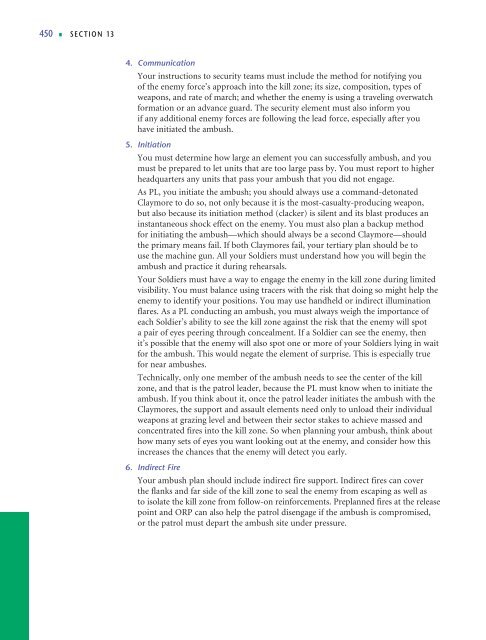Patrolling Organization.pdf - UNC Charlotte Army ROTC
Patrolling Organization.pdf - UNC Charlotte Army ROTC
Patrolling Organization.pdf - UNC Charlotte Army ROTC
- No tags were found...
Create successful ePaper yourself
Turn your PDF publications into a flip-book with our unique Google optimized e-Paper software.
450 • SECTION 134. CommunicationYour instructions to security teams must include the method for notifying youof the enemy force’s approach into the kill zone; its size, composition, types ofweapons, and rate of march; and whether the enemy is using a traveling overwatchformation or an advance guard. The security element must also inform youif any additional enemy forces are following the lead force, especially after youhave initiated the ambush.5. InitiationYou must determine how large an element you can successfully ambush, and youmust be prepared to let units that are too large pass by. You must report to higherheadquarters any units that pass your ambush that you did not engage.As PL, you initiate the ambush; you should always use a command-detonatedClaymore to do so, not only because it is the most-casualty-producing weapon,but also because its initiation method (clacker) is silent and its blast produces aninstantaneous shock effect on the enemy. You must also plan a backup methodfor initiating the ambush—which should always be a second Claymore—shouldthe primary means fail. If both Claymores fail, your tertiary plan should be touse the machine gun. All your Soldiers must understand how you will begin theambush and practice it during rehearsals.Your Soldiers must have a way to engage the enemy in the kill zone during limitedvisibility. You must balance using tracers with the risk that doing so might help theenemy to identify your positions. You may use handheld or indirect illuminationflares. As a PL conducting an ambush, you must always weigh the importance ofeach Soldier’s ability to see the kill zone against the risk that the enemy will spota pair of eyes peering through concealment. If a Soldier can see the enemy, thenit’s possible that the enemy will also spot one or more of your Soldiers lying in waitfor the ambush. This would negate the element of surprise. This is especially truefor near ambushes.Technically, only one member of the ambush needs to see the center of the killzone, and that is the patrol leader, because the PL must know when to initiate theambush. If you think about it, once the patrol leader initiates the ambush with theClaymores, the support and assault elements need only to unload their individualweapons at grazing level and between their sector stakes to achieve massed andconcentrated fires into the kill zone. So when planning your ambush, think abouthow many sets of eyes you want looking out at the enemy, and consider how thisincreases the chances that the enemy will detect you early.6. Indirect FireYour ambush plan should include indirect fire support. Indirect fires can coverthe flanks and far side of the kill zone to seal the enemy from escaping as well asto isolate the kill zone from follow-on reinforcements. Preplanned fires at the releasepoint and ORP can also help the patrol disengage if the ambush is compromised,or the patrol must depart the ambush site under pressure.
















